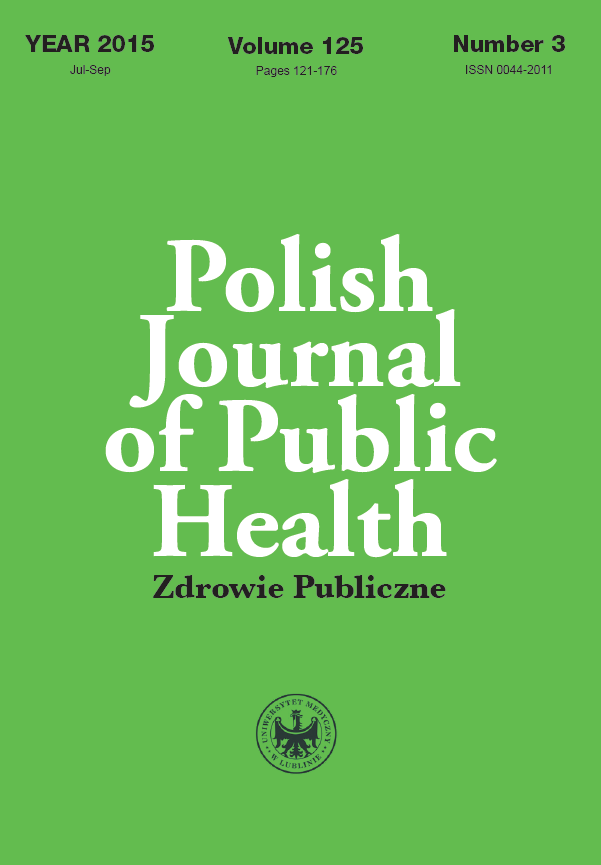Nurse care quality and hospital-acquired infections: adhering to aseptic techniques
DOI:
https://doi.org/10.1515/pjph-2015-0040Keywords:
prevention of hospital-acquired infections, adherence by aseptic techniques, quality of careAbstract
Introduction. The quality of medical services can be regarded as an indication of the changes being implemented at a given moment. At the same time, improving the care quality remains essential, regardless of the current situation. This makes upgrading employees’ skills a necessity, for instance by preventing undesired events, like hospital acquired infections which are quite common.
Aim. The aim of this study was to measure the quality of nursing care delivered to patients who contracted a hospital-acquired disease, with special attention paid to the adherence by aseptic procedures.
Material and methods. The authors of this research study want to assess the quality of nursing care, looking through the lens of adherence by aseptic techniques.
Results. The study was conducted in hospitals of three different referral levels. Both the highest (=95.7%) and the lowest (=84.7%) rates in the field of quality of nursing care were reported in provincial hospitals.
Conclusion. 1.There is a 10% deficit in terms of adherence to aseptic procedures. 2. Constant supervision and upgrading nursing staff skills is essential.
References
1. Golec M, Soluch S. Kompleksowe zarządzanie jakością w służbie zdrowia. Warszawa: Wydawnictwo KLIO; 2000.
2. Lenartowicz H. Zarządzanie jakością w pielęgniarstwie. Warszawa: Centrum Edukacji Medycznej; 1998.
3. Dobska M, Dobski P. TQM – zarządzanie przez jakość w zakładach opieki zdrowotnej. Poznań: Zakład Poligraficzny Mars Graf M. R. Sójka-Servmed; 2003.
4. Centers for Disease Control and Prevention. Guidance on Public Reporting of Healthcare –Associated Infections. Recommendations of the Healthcare Infection Control Practices Advisory Committee; 2005.
5. Kautsch M, Whitfield M, Klich J. Zarządzanie w opiece zdrowotnej: polsko-brytyjskie spojrzenie na zagadnienia zarządzania w ochronie zdrowia w nowym tysiącleciu. Kraków: Wydaw. Uniwersytetu Jagiellońskiego; 2001.
6. Fawcett-Henesy A. Quality Issues – the Nursing Role. Organizacja opieki pielęgniarskiej a zmiany w systemie ochrony zdrowia. Konferencja AM Lublin 7-8 maja 1993. Warszawa: Wyd. CEM; 1994.
7. Fawcett-Henessy A. Reformy systemów opieki zdrowotnej w Europie. Nowe wyzwania stawiane POZ. Pielęg. 1997;4(33):3-8.
8. Dzierżanowska D. Zakażenia szpitalne. Bielsko-Biała: ά- medica Press; 2008.
9. Fleischer M, Bober-Gheek B. Podstawy pielęgniarstwa epidemiologicznego. Warszawa: Centrum Kształcenia Podyplomowego Pielęgniarek i Położnych; 2006.
10. Romankiewicz E. Pilotażowe badania ryzyka zakażeń bakteryjnych przenoszonych przez ręce i odzież ochronną personelu medycznego. In: Piąta Ogólnopolska Konferencja – Jakość w opiece zdrowotnej. Kraków; 2000.
11. Fleischer M. Kontrola zakażeń w terapii dożylnej. Pielęgniarka Epidemiologiczna. Informator. Kwart Pol Stow Pielęg Epidemiol. 2006;4(27):12-22.
12. Leksowski K, Jasiński A, Marszałek A. Ocena skuteczności wybranych preparatów antyseptycznych stosowanych do dezynfekcji rąk przed zabiegami chirurgicznymi. Pol Merkuriusz Lek. 2001;11(62):151-3.
13. Worthington T, Tebbs S, Moss H, at al. Are contaminated flush solutions an overlooked source for catheter-related sepsis? J Hosp Infect. 2001;49:81-3.
14. Taxis K, Wirtz V, Barber N. Variations in aseptic techniques during preparation and administration of intravenous drugs – an observation-based study in the UK and in Germany. J Hosp Infect. 2004;56:79-81.
15. Frank U, Gastmeier P, Ruden H. The organization of infection control in Germany. J Hosp Infec. 2001;49:9-13.
16. Curran E. Reducing the risk of healthcare – acquired infection. Nurs Stand. 2001;16(1):45-52.
17. Wierzbińska M. Rękawice medyczne – profilaktyka zakażeń HBV, HCV, HIV. Zakażenia. 2005;5(6):71-2.
Downloads
Published
Issue
Section
License
Copyright (c) 2015 Polish Journal of Public Health

This work is licensed under a Creative Commons Attribution-NonCommercial-NoDerivatives 3.0 Unported License.


